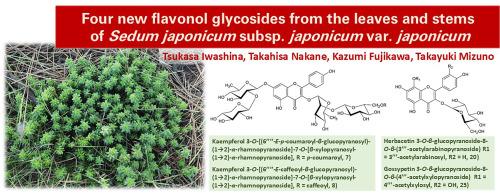从日本景天(Sedum japonicum)叶和茎中提取四种新的黄酮醇苷。日本花变种
IF 2
4区 生物学
Q4 BIOCHEMISTRY & MOLECULAR BIOLOGY
引用次数: 0
摘要
从日本景天(Sedum japonicum)的叶和茎中分离到了4个新的黄酮醇苷。含23种已知黄酮类化合物。他们确认为山柰酚3 -[(6”“-E-p-coumaroyl -β-d-glucopyranosyl) -(1→2)α-l-rhamnopyranoside] 7点——[β-d-xylopyranosyl -(1→2)α-l-rhamnopyranoside](7)、山柰酚3 -[(6”“-E-caffeoyl -β-d-glucopyranosyl) -(1→2)α-l-rhamnopyranoside] 7点——[β-d-xylopyranosyl -(1→2)α-l-rhamnopyranoside] (8), herbacetin 3 -β-d-glucopyranoside-8-O -β- d -(3“-acetylarabinopyranoside)(20)和gossypetin 3 -β-d-glucopyranoside-8-O -β- d -(4“HR-MS -acetylxylopyranoside)(25)紫外线,酸水解和核磁共振。并与日本其他两个品种和亚种(S. japonicum subsp)的黄酮谱进行了化学分类比较。日本花变种和日本花亚种。已被调查和报道的含有黄酮类化合物的米叶。本文章由计算机程序翻译,如有差异,请以英文原文为准。

Four new flavonol glycosides from the leaves and stems of Sedum japonicum subsp. japonicum var. japonicum
Four new flavonol glycosides were isolated from the leaves and stems of Sedum japonicum subsp. japonicum var. japonicum, together with 23 known flavonoids. They were identified as kaempferol 3-O-[(6′′′′-E-p-coumaroyl-β-d-glucopyranosyl)-(1→2)-α-l-rhamnopyranoside]-7-O-[β-d-xylopyranosyl-(1→2)-α-l-rhamnopyranoside] (7), kaempferol 3-O-[(6′′′′-E-caffeoyl-β-d-glucopyranosyl)-(1→2)-α-l-rhamnopyranoside]-7-O-[β-d-xylopyranosyl-(1→2)-α-l-rhamnopyranoside] (8), herbacetin 3-O-β-d-glucopyranoside-8-O-β-D-(3′′′-acetylarabinopyranoside) (20) and gossypetin 3-O-β-d-glucopyranoside-8-O-β-D-(4′′′-acetylxylopyranoside) (25) by UV, HR-MS, acid hydrolysis and NMR. Its flavonoid profiles were chemotaxonomically compared with those of Japanese other two variety and subspecies, S. japonicum subsp. japonicum var. senanense and S. japonicum subsp. oryzifolium var. oryzifolium which have been surveyed and reported for flavonoids.
求助全文
通过发布文献求助,成功后即可免费获取论文全文。
去求助
来源期刊

Biochemical Systematics and Ecology
生物-进化生物学
CiteScore
3.00
自引率
12.50%
发文量
147
审稿时长
43 days
期刊介绍:
Biochemical Systematics and Ecology is devoted to the publication of original papers and reviews, both submitted and invited, in two subject areas: I) the application of biochemistry to problems relating to systematic biology of organisms (biochemical systematics); II) the role of biochemistry in interactions between organisms or between an organism and its environment (biochemical ecology).
In the Biochemical Systematics subject area, comparative studies of the distribution of (secondary) metabolites within a wider taxon (e.g. genus or family) are welcome. Comparative studies, encompassing multiple accessions of each of the taxa within their distribution are particularly encouraged. Welcome are also studies combining classical chemosystematic studies (such as comparative HPLC-MS or GC-MS investigations) with (macro-) molecular phylogenetic studies. Studies that involve the comparative use of compounds to help differentiate among species such as adulterants or substitutes that illustrate the applied use of chemosystematics are welcome. In contrast, studies solely employing macromolecular phylogenetic techniques (gene sequences, RAPD studies etc.) will be considered out of scope. Discouraged are manuscripts that report known or new compounds from a single source taxon without addressing a systematic hypothesis. Also considered out of scope are studies using outdated and hard to reproduce macromolecular techniques such as RAPDs in combination with standard chemosystematic techniques such as GC-FID and GC-MS.
 求助内容:
求助内容: 应助结果提醒方式:
应助结果提醒方式:


